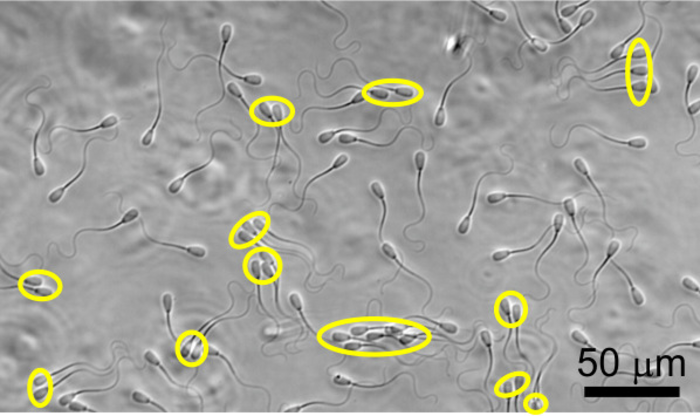Reviewed by Danielle Ellis, B.Sc.Sep 22 2022
Sperm actually swim better together when they are swimming against the current. Contrary to common belief, spermatozoa frequently cooperate to go through the female reproductive system in a variety of mammalian species, contradicting the notion that the fastest and fittest male reproductive cell wins the fertilization race.
 Coexistence of individually swimming and clustered sperm. Clustered sperm are labeled with yellow ovals. Scale bar: 50 μm. Image Credit: S Phuyal, SS Suarez, C-K Tung
Coexistence of individually swimming and clustered sperm. Clustered sperm are labeled with yellow ovals. Scale bar: 50 μm. Image Credit: S Phuyal, SS Suarez, C-K Tung
A recent study in the journal Frontiers in Cell and Developmental Biology provides some convincing arguments for the causes of a recently discovered clustering behavior.
The team’s earlier studies, led by researchers from Cornell University and North Carolina A&T State University, were the ones that first revealed that sperm naturally pull together without adhering to one another when swimming in viscoelastic fluid.
This type of fluid is what the sperm encounters as it travels through the cervix and uterus on its way to the oviduct, where the egg is fertilized. Think of melted cheese when using the term viscoelasticity to describe both thickness and flexibility.
However, unlike other examples of group activity, teams of unattached sperm do not outpace the solo swimmers. In contrast to lone sperm, the wood mouse sperm head possesses a hook that physically connects it to other sperm, joining hundreds to thousands of them in a sperm train.
Going against the flow
The study focused on currents of viscoelastic fluid moving through confined spaces in the female reproductive system to better understand the potential biological benefits of this substantial and challenging study activity.
They studied how sperm clustered in viscoelastic fluid responded to various flow scenarios using bovine sperm (a good model for the human type) and a microfluidic device to imitate the physical properties of the female tract.
Based on the force of the current that the sperm must travel against, they discovered three potential biological advantages to sperm clustering. First, clustered sperm appear to change direction less frequently and swim in a straighter path in the absence of flow.
Sperms that are clustered together are better oriented, like a school of fish swimming upstream, against a mild to intermediate flow. Finally, there seems to be safety in numbers when there is a high physiological flow rate to prevent getting swept away by the powerful flow.
In general, I would say that identification of motility advantages that are not speed enhancement is not usual, and therefore significant. In some ways we open new avenues for examination of sperm performance.”
Dr Chih-kuan Tung, Study Co-Author and Associate Professor, Physics, North Carolina A&T State University
Fertility needs Physics
Tung claimed that as an educated physicist, he is especially interested in the protective dynamics at work when the flow is at its strongest.
He added, “This may resemble the peloton formation in biking, although the fluid mechanics for sperm is drastically different from the bikers. We would certainly want to know more about this.”
It is not just for science buffs to enjoy seeing sperm swim. Treatments for infertility and other areas of medicine may be affected by a better knowledge of the physics governing how sperm travel through the complex female reproductive tract to fertilize the egg.
“In the longer term, our understanding may provide better selection of sperm used for intervention such as in vitro fertilization or other assisted-reproduction technologies. This may be needed as [these methods] typically skip some or all of the selection mechanisms present in the female tract and yield less favorable results,” Tung further stated.
Source:
Journal reference:
Phuyal, S., et al. (2022). Biological benefits of collective swimming of sperm in a viscoelastic fluid. Frontiers in Cell and Developmental Biology. doi:10.3389/fcell.2022.961623